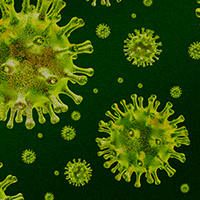Clinical and epidemiological profile of Indian COVID-19 patients from Jaipur: a descriptive study

Submitted: May 13, 2020
Accepted: December 14, 2020
Published: July 21, 2021
Accepted: December 14, 2020
Abstract Views: 1783
PDF: 812
Publisher's note
All claims expressed in this article are solely those of the authors and do not necessarily represent those of their affiliated organizations, or those of the publisher, the editors and the reviewers. Any product that may be evaluated in this article or claim that may be made by its manufacturer is not guaranteed or endorsed by the publisher.
All claims expressed in this article are solely those of the authors and do not necessarily represent those of their affiliated organizations, or those of the publisher, the editors and the reviewers. Any product that may be evaluated in this article or claim that may be made by its manufacturer is not guaranteed or endorsed by the publisher.
Similar Articles
- Yoldez Houcine, Chirine Moussa, Ahmed Ben Abdelaziz, Aida Ayadi, PD-L1 and molecular biomarker expression in non-small cell lung cancer in Tunisian patients , Monaldi Archives for Chest Disease: Vol. 94 No. 4 (2024)
- Mariam Lakara, Anil Kumar Patidar, Anil Sharma, Assessing the key factors contributing to non-adherence to pulmonary tuberculosis treatment: a descriptive study , Monaldi Archives for Chest Disease: Early Access
- Thomas Galasso, Lorenzo Corbetta, Laura Mancino, Lucio Michieletto, Loris Ceron, Statistical approach to mediastinal staging in NSCLC with M.E.S.S.i.a. software , Monaldi Archives for Chest Disease: Vol. 89 No. 3 (2019)
- James May, Katrina Mason, Parag Patel, Brendan Madden, A challenging case of tracheal foreign body retrieval following COVID-19 swabbing , Monaldi Archives for Chest Disease: Vol. 92 No. 3 (2022)
- Giulia Mattesi, Sara Di Michele, Donato Mele, Ilaria Rigato, Riccardo Bariani, Andrea Fiorencis, Marco Previtero, Abdullah Al Sergani, Loira Leoni, Barbara Bauce, Valeria Pergola, Thyroid dysfunction on the heart: clinical effects, prognostic impact and management strategies , Monaldi Archives for Chest Disease: Vol. 92 No. 4 (2022)
- Danish Abdul Aziz, Aiza Abbas, Werdah Viquar , Ali Munawar Hussain, Association of vitamin D levels and asthma exacerbations in children and adolescents: Experience from a tertiary care center , Monaldi Archives for Chest Disease: Vol. 93 No. 1 (2023)
- Joana Vieira Naia, Diana Pimenta, Anita Paiva, Rita Costa, Conceição Souto de Moura, Raquel Pereira, João Filipe Cruz, When benign leiomyomas metastasize to the lungs - a case report , Monaldi Archives for Chest Disease: Vol. 93 No. 4 (2023)
- Abdulameer A. Al-Mosawi, Hussein Nafakhi, Hadeel K. Hameed, Aortic root diameter, main pulmonary artery diameter/aortic root diameter and pericardial fat volume as predictors of occlusive coronary artery disease , Monaldi Archives for Chest Disease: Vol. 94 No. 2 (2024)
- Unnati Desai, Saby AK, Ketaki Utpat, Jyoti Bacche, Role of GeneXpert in the diagnosis of extrapulmonary tuberculosis , Monaldi Archives for Chest Disease: Early Access
- Eduardo M. Vilela, Susana Torres, Helena Gonçalves, João Primo, Madalena Teixeira, Pedro Braga, Complete atrioventricular block during exercise: New insights from an old test , Monaldi Archives for Chest Disease: Vol. 89 No. 1 (2019)
<< < 101 102 103 104 105 106 107 108 109 110 > >>
You may also start an advanced similarity search for this article.

 https://doi.org/10.4081/monaldi.2021.1377
https://doi.org/10.4081/monaldi.2021.1377





